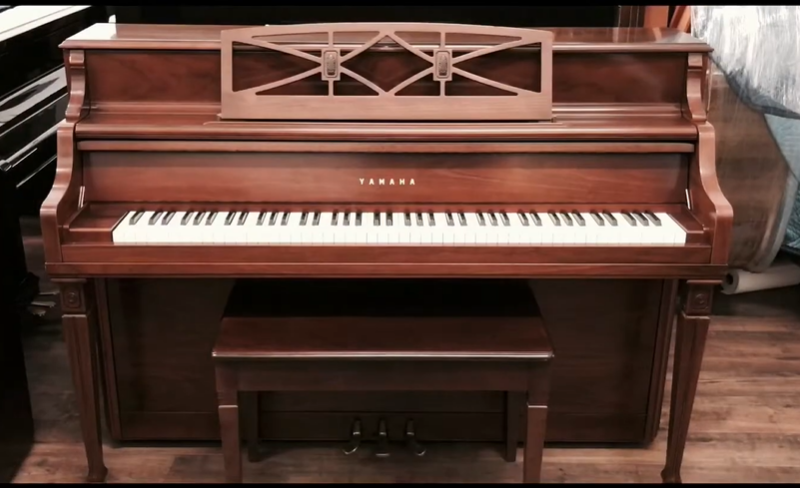Imagine bringing the elegance and charm of a grand piano into your home without the need for a concert hall-sized space. That’s the allure of the console piano, a perfect blend of style and functionality.
Whether you’re a seasoned pianist or just starting your musical journey, understanding what makes a console piano unique can transform your musical experience. You’re about to discover how this compact yet powerful instrument can fit seamlessly into your life, offering rich sound and aesthetic appeal.
With its distinct features and benefits, the console piano might just be the perfect addition to your home. Ready to uncover why this instrument could be your next musical companion? Keep reading to find out more.

Credit: www.kawaipianoshouston.com
Console Piano Features
The console piano is a popular choice for many music enthusiasts. It offers a blend of elegant design and rich sound quality. Understanding its features can help you appreciate this instrument more.
Table of Contents
ToggleDesign And Structure
The console piano boasts a sleek and modern design. Its compact frame fits well in most home settings. The vertical structure saves space while offering full-sized keys. This gives it a classic look without occupying too much room.
Sound Quality
The sound quality of a console piano is impressive. It delivers warm tones that fill a room. The strings and hammers are finely tuned for clarity. This ensures a pleasant listening experience for players and listeners alike.
Size And Space Efficiency
A console piano is known for its size efficiency. It stands around 40 to 44 inches tall. This makes it smaller than a traditional upright piano. Its design is perfect for apartments or small spaces. This allows you to enjoy piano music without the need for a large room.

Credit: www.kawaipianoshouston.com
Historical Background
Console pianos emerged in the 20th century as a compact alternative to larger upright pianos. They feature a shorter string length and smaller soundboards, making them ideal for home use. This design maintains quality sound while fitting comfortably in smaller spaces.
The console piano holds a special place in the world of music, with its unique blend of elegance and functionality. Understanding its historical background helps you appreciate its significance in today’s musical landscape. Let’s dive into its origins and how it has evolved over time.
Origins Of Console Piano
The console piano emerged in the early 20th century. It was a period marked by an increasing demand for musical instruments that fit snugly into homes. Families wanted pianos that were not just functional but also compact enough for smaller spaces. This desire led to the creation of the console piano, characterized by its medium height and shorter strings. Its design allowed it to produce a rich sound without taking up too much room. This was a game-changer for many households, adding music to family gatherings and personal leisure.
Evolution Over Time
The console piano has undergone significant changes since its inception. Manufacturers began experimenting with different materials and construction techniques. This experimentation aimed to improve sound quality and durability while maintaining the piano’s compact size. In the mid-20th century, the popularity of console pianos surged. They became a staple in homes, schools, and even churches. Their affordability and versatility made them a preferred choice for budding pianists and seasoned players alike. Today, the console piano continues to be cherished by music enthusiasts. It blends traditional craftsmanship with modern innovations, ensuring it remains relevant in an ever-evolving musical world. If you own a console piano, consider how this piece of history enriches your musical journey. Have you ever wondered how a piece of furniture could shape musical history? The console piano is a testament to how practicality and creativity can harmoniously coexist. As you explore its rich past, you might find yourself listening to its notes with newfound appreciation.
Comparison With Other Pianos
Understanding the differences between console pianos and other types can be a game-changer in your musical journey. Each piano offers unique features and advantages, and knowing these can help you make a more informed choice. Let’s dive into how console pianos stack up against their upright and grand counterparts.
Upright Vs Console
Upright pianos are typically taller and heavier than console pianos. While both are vertical, the console is known for its compact design, making it a popular choice for smaller spaces. An upright can offer richer sound due to its larger soundboard and longer strings.
Console pianos are often more affordable, which might appeal to those on a budget. The shorter height makes it easier to fit into apartments or smaller homes. If you value portability and affordability, the console piano is worth considering.
Think about your room space and how often you might move the piano. If you’re in a transient stage of life, like college or frequent relocations, a console piano could save you a lot of hassle.
Grand Vs Console
Grand pianos are the epitome of elegance and sound quality. Their horizontal design allows for longer strings, producing a more resonant and dynamic sound. Console pianos, while not as sonorous, offer practicality that a grand piano might lack.
If you have space and budget, a grand piano can be a centerpiece of your living room. But if you’re limited in either, a console piano can be a smart alternative. It offers decent sound quality without demanding the space or financial commitment a grand piano requires.
Consider how you plan to use your piano. Are you hosting concerts or playing for personal enjoyment? For casual playing, a console piano can be more than adequate. Yet, if you dream of producing concert-level performances, investing in a grand might be your path.
Ultimately, your choice should reflect your lifestyle and priorities. What matters more to you: space and convenience, or sound and grandeur? Your answer will guide you to the perfect piano fit for your needs.
Benefits For Musicians
Console pianos offer musicians a compact size with rich sound quality. Their vertical design saves space while delivering vibrant tones. Ideal for home use, these pianos provide an affordable option without sacrificing musical depth.
The console piano, often overlooked in favor of grand and upright pianos, offers unique benefits for musicians. Its compact size and affordability make it an excellent choice for those starting their musical journey or looking to expand their range. Whether you’re a beginner testing the waters or an experienced musician exploring new styles, the console piano can be a valuable addition to your musical repertoire.
Ideal For Beginners
Starting with a console piano can be a game-changer for beginners. Its user-friendly design and manageable size help ease new players into the world of music without feeling overwhelmed. You can place a console piano in your living room, bedroom, or any small space, making practice sessions more accessible and frequent. The keys on a console piano offer a similar touch to larger pianos, allowing you to develop the correct finger strength and technique from the beginning.
Versatility In Music Genres
Console pianos aren’t limited to just classical music. They are versatile instruments that can adapt to various genres, from jazz to pop. Imagine playing a soulful blues piece in the afternoon and switching to a lively rock tune by evening. This flexibility encourages you to experiment and expand your musical horizons. With a console piano, you can explore and connect with different styles of music, making your musical journey more enriching and exciting. Have you ever thought about how experimenting with different genres could enhance your skills and creativity?
Choosing The Right Console Piano
Choosing the right console piano can be a rewarding experience. Console pianos offer compact size and excellent sound quality. These features make them ideal for homes. Picking the right one involves considering several factors. It’s important to find a piano that suits your needs and budget.
Factors To Consider
Space is a crucial factor. Console pianos are smaller than grand pianos. They fit well in apartments and small rooms. Sound quality is equally important. Look for pianos with rich, full tones. Durability matters, too. A well-built piano lasts for many years. Consider the material used in construction. Wood types affect sound and longevity. Price is also a key consideration. Set a budget before shopping. Compare features within your price range.
Popular Brands And Models
Yamaha is a trusted name in pianos. Their console models are known for quality. Kawai offers reliable and affordable options. Their pianos provide great sound and value. Steinway & Sons are famous for craftsmanship. Their pianos are top-tier but pricey. Baldwin has been popular for decades. Their models blend tradition and innovation. Research these brands thoroughly. Choose a model that fits your needs.
Maintenance Tips
Maintaining a console piano ensures its longevity and optimal performance. Regular care and professional servicing are crucial. This section provides tips to help keep your console piano in excellent condition.
Regular Care Practices
Keep your piano clean and dust-free. Use a soft cloth to wipe surfaces gently. Avoid using harsh chemicals or polishes. Place the piano away from direct sunlight and heat sources. This prevents damage to the wood and tuning stability. Maintain a stable room temperature and humidity level. These conditions help preserve the piano’s sound quality.
Professional Servicing
Schedule regular tunings with a professional technician. Twice a year is ideal for most pianos. Tunings keep the instrument sounding its best. Consider a technician for internal cleaning and inspections. They can identify potential issues early. Regular servicing extends the life of your piano. It ensures the instrument remains in top playing condition.

Credit: kawaius.com
Frequently Asked Questions
What Is A Console Piano?
A console piano is an upright piano with a height of 40 to 44 inches. It features a compact design, making it ideal for homes and small spaces. The strings and action are vertically aligned, offering rich sound quality in a smaller frame compared to grand pianos.
Is Console Piano Good?
Console pianos offer a compact design, making them ideal for smaller spaces. They provide good sound quality and are often more affordable than grand pianos. Their upright structure allows for easier placement in homes, while still delivering a satisfying musical experience for both beginners and experienced players.
How Do I Know If My Piano Is A Console Or Spinet?
Check the piano’s height. Consoles are 40-43 inches tall, while spinets are 36-39 inches. Look at the action mechanism too. Consoles have a direct blow action, while spinets use a drop action. These differences help identify your piano type.
What Is The Difference Between A Studio Piano And A Console Piano?
Studio pianos are taller, typically 45-48 inches, offering richer sound due to larger soundboards. Console pianos stand 40-44 inches tall, providing a more compact design suitable for smaller spaces. Studio pianos often have a more responsive action, making them ideal for serious musicians.
Console pianos are more affordable and fit casual players.
Conclusion
Exploring console pianos reveals their unique charm and design. Compact and stylish, they fit well in smaller spaces. Their sound quality suits both beginner and advanced players. Console pianos offer a beautiful blend of form and function. Choosing one depends on personal taste and needs.
Consider size, sound, and aesthetics before purchasing. Console pianos stand out for their versatility and elegance. Great for homes and studios alike. Discover the joy of playing on a console piano. Perfect for those seeking both beauty and performance in a piano.

